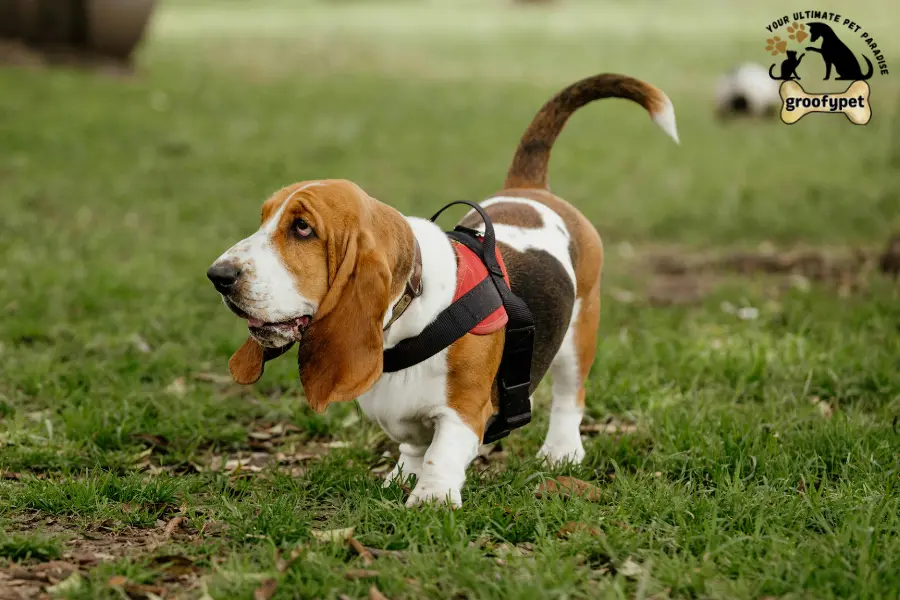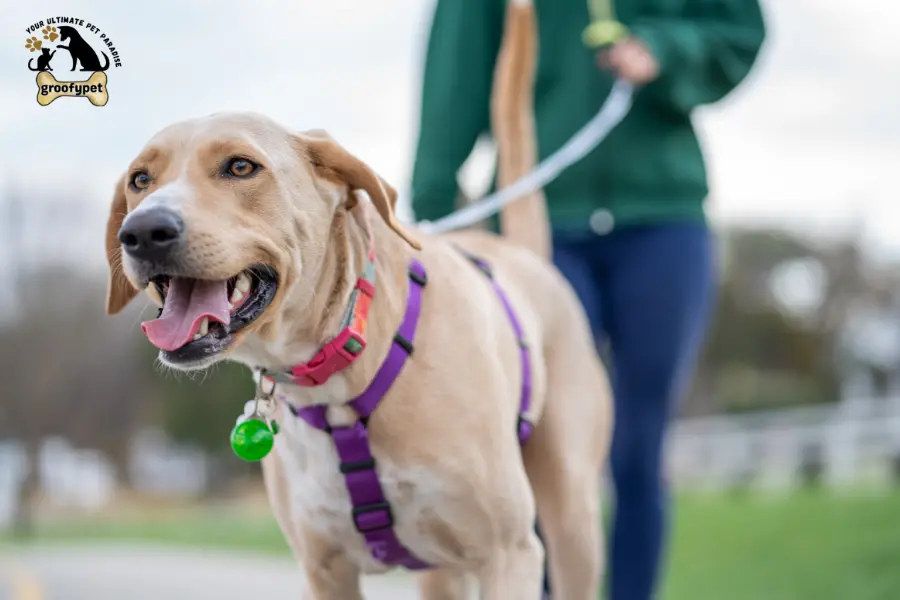
Why is my dog walking slowly with its head down?” If you’ve asked yourself this during a walk, it might seem like your dog is just tired or being lazy, but it could be something more.
A slow walk with their head hanging low can be your dog’s way of telling you they’re not feeling right. It might be pain, stress, anxiety, or even boredom. In this post, I’ll explain five common reasons why my dog is walking slow with head down, how to spot the signs, and what you can do to help. When you understand what your dog is trying to tell you, you can make their walk and their life more comfortable.
If your dog is walking slowly with their head down, it’s not random. Most dogs get excited for walks, so when they suddenly slow down, it usually means something’s wrong. Dogs show how they feel through body language, and this kind of change is a sign they might be uncomfortable, stressed, or unsure.
Many people think their dog is tired or stubborn, but it’s often more than that. It could be pain, anxiety, or a lack of confidence. If we ignore these signs, the problem can get worse—pain might grow, stress can build up, and walks may start to feel scary instead of fun.
You can make the right changes once you understand why your dog is acting this way. That might mean a trip to the vet, a gentler routine, or working on their confidence. The goal is to help your dog feel safe and happy and enjoy their walks again.
Five common reasons my dog is walking slow with head down
1) Pain: Could Your Dog Be Uncomfortable?
If my dog is walking slow with head down, they might be in pain. Dogs don’t always show when they’re hurting, so changes in how they move can be an important sign.
Watch for signs like your dog slowing down, keeping their head low, or not wanting to walk. These could mean something is wrong.
Common Reasons for Pain in Dogs:
- Joint pain from arthritis or hip problems, especially in older dogs
- Muscle strain or injury from too much play or slipping
- Paw issues like cuts, burns, or something stuck in their paw
- Other health problems like infections or nerve issues that make it hurt to move
What to Do:
- Take a close look at your dog’s paws.
- check for cuts, burns, or anything stuck between the pads.
- Watch how they move: are they slow to get up, avoiding stairs, or walking stiffly?
- If you notice ongoing changes in their movement or behavior, book a vet appointment to rule out pain or injury.
- Even everyday activities can become overwhelming if your dog is hurting, so it’s important to address any physical discomfort first.
- If health isn’t the problem, consider emotional causes like stress or anxiety, which can also make your dog reluctant to walk.
2) Fear & Stress – Is Your Dog Feeling Overwhelmed?
Sometimes dogs don’t slow down on walks because they’re tired or in pain—they might just be stressed or unsure. If my dog is walking slow with head down, pausing often, or seems nervous, they could be feeling overwhelmed by their surroundings.
Some dogs get on edge, noticing every sound, smell, or movement, while others just shut down when it all gets too much.
Some common things that might make your dog slow down
- Loud noises like traffic, sirens, or garbage trucks
- Other dogs or people, especially if your dog is reactive
- Harsh leash corrections or scolding, which can make them unsure about moving forward
- Busy streets or places with too much going on
When too many of these things happen at once, your dog might experience something called trigger stacking—where small stresses build up and become overwhelming. This can lead to your dog freezing, shutting down, or refusing to walk. I’ve written more about trigger stacking on my blog if you want to learn how to help your dog through it.
What to Do:
- Start by noticing what’s bothering your dog.
- Are they slowing down near certain places or reacting to sounds, people, or other dogs?
- Spotting these stress points is the first step.
- Next, ease up on expectations—if your dog is stressed, pushing them will only make it worse.
- Let them go at their own pace and avoid forcing them into situations that feel like too much.
- Use positive reinforcement to build their confidence.
- Whether they calmly pass a trigger or choose to walk away instead of shutting down, reward it.
- Also, make your communication clear.
- Dogs feel more secure when they understand what you want and what you don’t.
3) Boredom—Is Your Dog Disengaged?
Many dog owners think their pets love every walk, but sometimes the same route over and over can get boring for dogs. While exercise is important, dogs also need mental challenges to keep them happy. If a walk feels dull or has no clear purpose, dogs might lose interest, slow down, stop often, or just seem like they don’t care.
Some signs your dog might be bored on walks
- Dragging their paws, looking bored, or stopping a lot
- Sniffing around a lot but without really focusing or exploring
- Showing obsessive behaviors like chasing birds, picking up random things, or staring fixatedly at moving objects
What to Do:
- Try a new route—walk different streets or even go the opposite way you usually do.
- It makes the walk more interesting for your dog.
- Make walks fun—hide treats or your dog’s food for them to find, let them sniff around, or play games like tug or practice some commands.
- Think beyond walks—some dogs enjoy activities like scent games, agility, or bitework more than just walking.
- Replace boring walks with better activities—if your dog isn’t excited about walks, it’s okay to skip them sometimes.
- Instead, find something your dog really enjoys that fits their natural needs.
- Dogs get bored when their instincts aren’t met, so breed-specific activities can help a lot.
- If your dog seems tired of walks, check out my blog to find the right activities based on your dog’s breed.
4) Anxiety—When Your Dog Feels Unsure or Lacks Confidence
Sometimes dogs feel unsure or nervous about new places, people, or other dogs. When they lack confidence, they might seem hesitant or scared to explore.When my dog is walking slow with head down, you might notice them walking slowly, crouching down a bit, or not wanting to move forward, especially somewhere new.
An anxious dog often keeps their head low, tucks their tail, or stops a lot because they don’t feel comfortable. They’re not ignoring things—they’re just feeling worried.

Some signs your dog’s anxiety is holding them back
- Walking with their head down, ears back, or tail tucked
- Hesitating before moving or stopping often
- Avoiding eye contact or looking around nervously
- Staying close to you, hiding behind you, or asking for comfort during walks
What to do?
Build your dog’s confidence: Help your dog feel confident by introducing new places little by little and making it fun. Let your dog go at their own speed —don’t force them into things they’re not ready for. Cheer them on for small steps, like moving forward, checking something out, or exploring without being scared. Celebrate small wins of your dog.
5) – Disengagement
Many dog owners find daily walks turn into a monotonous routine—same time, same route, same pace—often squeezed in before work or during a hectic day. When the routine never varies and the dog isn’t allowed to sniff, explore, or set their own pace, the walk quickly loses its meaning. Rushing or dragging your dog along only makes things worse.When my dog is walking slow with head down? It might be your dog signaling they’re mentally checked out, bored, emotionally flat, or simply going through the motions.
In other situations, some dogs approach walks with anxiety. They may have experienced unpredictable encounters, loud noises, or negative interactions with other dogs that put them on edge. Instead of looking forward to their walk, they’re tense and uneasy even before stepping outside—like a ticking time bomb ready to explode.
Forget the idea that longer walks are always best. Shorter walks filled with plenty of sniffing, exploring, and downtime can be much more valuable—especially when combined with activities tailored to your dog’s breed (you can learn more about breed-specific outlets here).
Signs that disengagement is slowing your dog down
- Change your walking routes regularly to introduce new sights and smells, helping reduce the stress your dog might anticipate.
- Complement walks with breed-appropriate activities at home like flirt pole play, cardboard shredding boxes, or scent games to keep them engaged.
- longer, more focused walks for weekends or days when you’re not rushed—your own energy has a big impact on your dog’s experience.
What to do?
- Pause and ask yourself: Is this walk truly benefiting your dog, or just fitting into your schedule?
- Building confidence takes time, and it’s tough for dogs to learn new coping skills when they’re already overwhelmed.
- Reducing unnecessary stressors to create a calmer baseline.
- Introducing structured rest to avoid overstimulation.
- Offering engaging outlets and stimulation to help manage stress and frustration.
- By emphasizing calmness, fulfillment, and the right structure, this detox helps dogs develop a more balanced, confident mindset.
Also Read : How to Tire a Puppy Out?
Frequently Asked Questions
Why is my dog walking slowly with their head down?
Sometimes dogs walk slowly because they’re tired, hurting, or just not feeling great. Other times, they might be feeling a bit nervous or bored. Paying attention to how they act can give you clues.
How can I make walks more fun for my dog?
Mix things up! Try new paths, or take little breaks.
Does slow walking always mean something’s wrong?
Not really. Dogs sometimes just like to take their time and explore. and walk slowly.
How can I tell how my dog is feeling on a walk?
Watch their body — their ears, tail, and how excited or relaxed they seem. If they look calm and curious, they’re probably happy. If they seem tense or scared, they might be stressed.
Final Thoughts
When my dog is walking slow with head down, it’s easy to just focus on that behavior. But like with many dog training problems, the real reasons are often deeper. It could be pain, stress, fear, boredom, or maybe the walk just isn’t what they need. Taking the time to understand what’s really going on helps your dog feel better both on walks and in everyday life.
By paying attention to how your dog acts, how much energy they have, and how interested they seem, you can make small changes to support them better.
That might mean a trip to the vet, cutting down on things that stress them out, adding fun activities to walks, or helping them feel more confident. Even small changes can make a big difference in how your dog sees the world.Most of the time, the answer isn’t more training — usually, you’re already doing the right stuff. It’s about keeping things simple, meeting their basic needs, and giving them space to relax and feel calm again.
Dog Aggressive After Rabies Shot: Signs, Causes and Tips
Why Is My Dog Stumbling Around? Discover Shocking Reasons!





